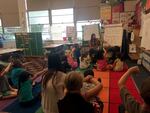Oregon’s achievement gap between white students and children of color shows up in kindergarten, according to scores out Thursday.

Harrison Park teacher Donna Shinagawa quizzes incoming kindergarten students and teaches the importance of taking turns.
Rob Manning / OPB
But a comparison of Kindergarten Assessment results — and test scores from older students — show some of those gaps change over time.
The gaps at kindergarten have state officials emphasizing the importance of what children are exposed to before they get to school.
“This data confirms that we have significant gaps, in terms of resource, and in terms of opportunity and in terms of the types of early learning experiences that children from different groups are able to receive and experience throughout our state," said Brett Walker, education specialist with Oregon's Early Learning Division.
Walker said the Early Learning Division will discuss the results with Oregon's network of Early Learning Hubs, which were created to help public and private providers of early childhood education. He said the results need deeper analysis to draw conclusions about how various preschool efforts are working and aligning with local schools.
The Kindergarten Assessment shows white children are better prepared for math than black and Hispanic youngsters when they show up in school. The "Numbers & Operations" test includes identifying numbers and simple arithmetic. Oregon's white students correctly answered, on average, 8.9 out of 16 math questions. Three historically under-served student groups slightly lag behind their white counterparts as they start kindergarten: Black students correctly answered 7.5 correctly on average, for Native American students it was 7.7 and Hispanic students slightly lower at 7.4.
As students get older, gaps remain in place, or get larger for some student groups, when it comes to math. The most recent third grade state tests show that 54.5 percent of white students are at grade level in math, while the passing rates for students of color are far lower: 31.5 percent for Native American students, 29 percent for Hispanic students and 22.4 percent for black students.
It's a similar gap when it comes to early literacy — another key learning area measured on the Kindergarten Assessment.
Black children come to kindergarten just slightly below the state average at recognizing letters and letter sounds, based on three different measures the state uses (recognizing uppercase letters, identifying lowercase letters and understanding letter sounds). Native American children are a little further below the state average and Hispanic kindergarteners are lower still.
By the time students take the third-grade reading test, white students are passing the English Language Arts exams at a 54.7 percent rate, with black third-graders performing far below that — passing just 26.2 percent of the time. But Hispanic students caught up with their African-American counterparts, on average, with a 28.1 percent passing rate. Native American students are above both those ethnic groups but still well below white students, at a 31.7 percent passing rate.
The results for the two exams are not judging the same students. The kindergarten results relate to current (2016-17) kindergarten students and the third-grade results relate to students who were in that grade last school year (2015-16) and took the state standardized exams.
